Trending
Israeli strikes kill 22 in Beirut as Hezbollah official evades assassination
Published
6 months agoon
By
Ekwutos BlogBy Maya Gebeily and Alexander Cornwell
BEIRUT/JERUSALEM (Reuters) -Israeli strikes killed 22 people and injured more than 100 in central Beirut on Thursday, Lebanese authorities said, as a senior Hezbollah official evaded an Israeli assassination attempt in the city, according to three security sources.

A man walks next to a damaged building at the site of an Israeli air strike, amid ongoing hostilities between Hezbollah and Israeli forces, in Beirut, Lebanon, October 11, 2024. REUTERS/Louisa Gouliamaki
© Thomson Reuters
In Lebanon’s south, two United Nations peacekeepers were injured when an Israeli tank fired at a watchtower at the force’s main headquarters in Naqoura, prompting the U.N. to say its personnel were facing increasing danger.
The conflict between Israel and Hezbollah erupted one year ago when the Iranian-backed group opened fire in support of Palestinian militant group Hamas at the start of the Gaza war.

Rubble lies on top of a damaged vehicle at the site of an Israeli air strike, amid ongoing hostilities between Hezbollah and Israeli forces, in Beirut, Lebanon, October 11, 2024. REUTERS/Louisa Gouliamaki
© Thomson Reuters
It has intensified dramatically in recent weeks, with Israel bombing Beirut’s southern suburbs, the south and the Bekaa Valley, and killing many of Hezbollah’s top leaders.
Wafiq Safa, who heads Hezbollah’s liaison and coordination unit responsible for working with Lebanese security agencies, was targeted by Israel on Thursday night but survived, the security sources said.
The Israeli strikes hit a densely packed residential neighbourhood of apartment buildings and small shops in the heart of Beirut.
“I was praying. We heard the first strike and I thought it was in my house. The second one was much more powerful than the first one,” said Ala’a Baydoun, a resident whose house was damaged. “I went to see where the strike was and I saw that in my house, the glass and windows had shattered. We came and saw this scene. It was a horrifying scene, it was something unbelievable.”
Israel did not issue evacuation warnings ahead of the strikes and had not previously attacked the area, which is removed from Beirut’s southern suburbs where Hezbollah’s headquarters have been repeatedly bombed by Israel.
Lebanon’s Health Ministry reported 22 people killed and 117 wounded. Among the dead was a family of eight, including three children, who had evacuated from the south, according to a security source.

A man sits next to the rubble at the site of an Israeli air strike, amid ongoing hostilities between Hezbollah and Israeli forces, in Beirut, Lebanon, October 11, 2024. REUTERS/Louisa Gouliamaki
© Thomson Reuters
Israeli strikes have killed at least 2,169 people in Lebanon over the last year, the Lebanese government said in its daily update. The majority have been killed since Sept. 23, when Israel expanded its military campaign. The toll does not distinguish between civilians and combatants.

People gather near a damaged building at the site of an Israeli air strike, amid ongoing hostilities between Hezbollah and Israeli forces, in Beirut, Lebanon, October 11, 2024. REUTERS/Louisa Gouliamaki
© Thomson Reuters
The attempt to kill Safa, whose role merges security and political affairs, marked a widening of Israel’s targets among Hezbollah officials, which previously focused on the group’s military commanders and top leaders.
There was no immediate comment on the incident by Israel or by Hezbollah.
Lebanese authorities and Hezbollah have both endorsed a ceasefire as a means to end the conflict, but diplomats fear that diplomacy has taken a back seat to military operations.
Lebanon’s acting U.N. Ambassador Hadi Hachem told the council that “only diplomatic solutions and the implementation of international resolutions, the commitment to international law and international humanitarian law is the means to end this war and this aggression.”
PEACEKEEPERS ‘IN JEOPARDY’
Israel did say it had killed Muhammad Abdullah, the head of the Islamic Jihad’s network in the Palestinian refugee camp of Nur Shams in the West Bank. The Palestinian health ministry said on Friday that two people were killed in an Israeli strike on Nur Shams.
Abdullah, who Israel said had been involved in a number of attacks against its soldiers, was killed along with another “terrorist” in a strike near Tulkarm, the military and security agency said in a statement on Friday.
The United Nations’ peacekeeping force in Lebanon, UNIFIL, said two of its personnel were injured when an Israeli tank fired at a watchtower on Thursday at its main headquarters in Naqoura, hitting the tower and causing the peacekeepers to fall.
The two peacekeepers were from Indonesia’s contingent and were in good condition after being treated for light injuries, Indonesia Foreign Minister Retno Marsudi said in a statement.
The safety of more than 10,400 U.N. peacekeepers in Lebanon is “increasingly in jeopardy” and operations have virtually halted since late September, U.N. peacekeeping chief Jean-Pierre Lacroix told the Security Council. That coincides with Israel’s escalation of its conflict with Lebanon.
UNIFIL called attacks on peacekeepers “a grave violation of international humanitarian law.”
The White House said the U.S. was deeply concerned by reports that Israeli forces fired on U.N. positions and was pressing Israel for details.
Israel’s military said in a statement its troops operated in the Naqoura area, “next to a UNIFIL base.”
“Accordingly, the IDF instructed the U.N. forces in the area to remain in protected spaces, following which the forces opened fire in the area,” Israel’s statement said, adding it maintains routine communication with UNIFIL.
The peacekeepers are determined to remain at their posts despite Israeli attacks and orders by Israel’s military to leave, the force’s spokesperson Andrea Tenenti said.
In New York, Israel’s U.N. Ambassador Danny Danon said Israel recommends UNIFIL relocate 5 km (3 miles) north “to avoid danger as fighting intensifies”.
Danon said attacking Hezbollah was necessary so 70,000 displaced Israelis could return to homes in northern Israel.
The Middle East remains on high alert for further escalation in the region, awaiting Israel’s response to an Iranian missile strike on Oct. 1.
U.S. vice president and Democratic presidential candidate Kamala Harris said de-escalation was needed.
“We have got to reach a ceasefire,” Harris told reporters as she departed Las Vegas, while commenting on the situations in Gaza and Lebanon. “We’ve got to de-escalate.”
A ceasefire remains elusive in Gaza and Lebanon. Washington’s occasional condemnation of Israel over civilian deaths has mostly been verbal with no substantive change in policy.
(Additional reporting by Michelle Nichols at the United Nations, Laila Bassam and Amina Ismail in Beirut, Tom Perry in London, Maayan Lubell in Jerusalem, Clauda Tanios, Tala Ramadan and Ahmed Elimam in Dubai, Kanishka Singh in Washington, John Irish in Paris; Writing by Lincoln Feast; Editing by Raju Gopalakrishnan)
You may like


Ukraine seeks to reassure Brussels by drawing red lines on US minerals deal


‘Hon Natasha Osawaru nee Idibia’ – Reactions as 2baba’s fiancée introduces herself


Kneel before Wike, beg him – Former gov’ship candidate, Eradiri tells Fubara
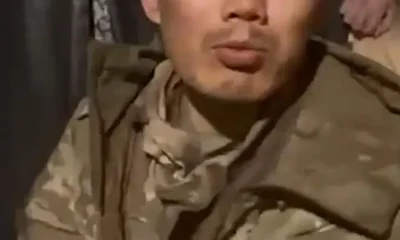

Ukraine has captured ‘two CHINESE nationals fighting for Russia’


PLATEAU KILLINGS: IGP ORDERS IMMEDIATE DEPLOYMENT OF ASSETS, TACTICAL SQUADS.
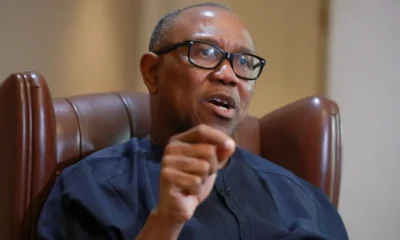

Don’t fear anybody, speak up, Nigeria is collapsing – Peter Obi tells opposition
Trending
‘Hon Natasha Osawaru nee Idibia’ – Reactions as 2baba’s fiancée introduces herself
Published
6 hours agoon
April 9, 2025By
Ekwutos Blog
The burning question on people’s lips is: ‘Nee Idibia?’
Honourable Natasha, the fiancée of controversial veteran singer, Innocent Idibia, popularly known as 2face or 2baba, has stirred up public reactions after she introduced herself to her colleagues in the Edo State House of Assembly.
Nigerians react
Does she know what Nee means?
You know I even paused for a second
I confused oo. Abi na me be the mumu.
Going further to explain the error, a user with the handle @Wandelakanu_ commented, Nee Idibia ??? Does she even know what “Nee” means ?? Shouldn’t she have said Hon. Natasha Irobosa Idibia Nee Osarawu ?
The user @HowKilts replied, Nee should mean her fathers name.
Concerned about the marriage ceremony, a user identified as Adewale Damilare wrote, These guys are married already. But having it secretly isn’t an honorable thing though!
The Edo Lawmaker has also changed her name on her Instagram page. It now appears as ‘Honourable Natasha IDIBIA.’
Trending
Ukraine has captured ‘two CHINESE nationals fighting for Russia’
Published
6 hours agoon
April 9, 2025By
Ekwutos Blog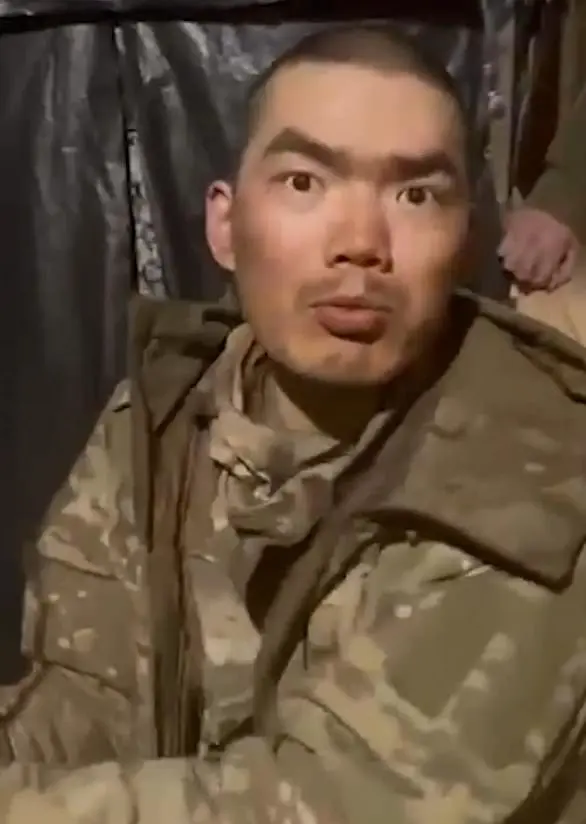
- This news is breaking: more to follow
Ukrainian President Volodymyr Zelensky said today that Ukraine had captured two Chinese nationals fighting for Russia.
‘Our military captured two Chinese citizens who fought in the Russian army,’ he claimed in a post on Telegram today.
‘This happened on the territory of Ukraine – in the Donetsk region. There are documents of these prisoners, bank cards, personal data.’
He said Ukraine had information that there were ‘significantly more Chinese citizens’ still among the Russian units, adding: ‘We are currently clarifying all the facts.’
Zelensky said he had asked his Foreign Minister to contact Beijing ‘and find out how China is going to react to this’.
‘Russia’s involvement, directly or indirectly, in this war in Europe is a clear signal that Putin is going to do anything, except end the war. He is looking for a way to continue fighting,’ he said, calling on the U.S. and Europe to ‘react’.
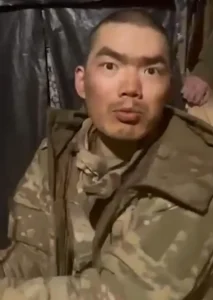
Video purported to show Chinese citizens detained after fighting for Russia
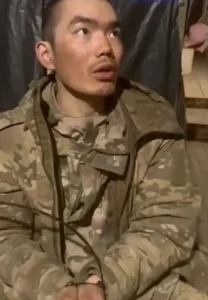
Zelensky said they had reason to believe there were ‘significantly more’ in the Russian ranks
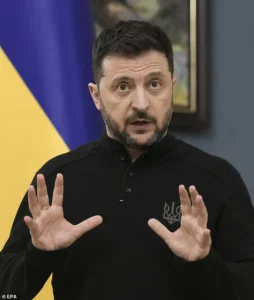
Ukrainian President Volodymyr Zelensky addresses a press conference in Kyiv, April 4, 2025
Zelensky said that the prisoners were currently in the custody of the Security Service of Ukraine.
‘Relevant investigative and operational actions are underway.’
If confirmed, the presence of Chinese soldiers on the battlefield would be a major development in the three-year invasion.
Russia was last year accused of drawing in some 12,000 North Korean troops after Ukraine launched a stunning counteroffensive into Kursk and Belgorod.
Hundreds of Yemeni mercenaries were then claimed to have been press-ganged into fighting for Russia in Ukraine, having been lured in with the promise of well-paid work and Russian citizenship.
Some said they were tricked into joining after signing enlistment contracts they could not read, and were told they would be working in lucrative fields like engineering.
When they arrived in Russia, a recruit said a man fired a pistol above their heads and ordered them to sign a contract before they were taken to Ukraine on buses.
Nepal and Sri Lanka also had to warn their people not to be lured in by false promises as it emerged hundreds of their citizens had joined the Russian invasion as mercenaries.
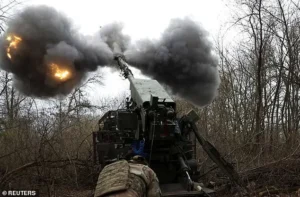
A Ukrainian howitzer fires towards Russian troops on the Donetsk frontline, on April 6, 2025
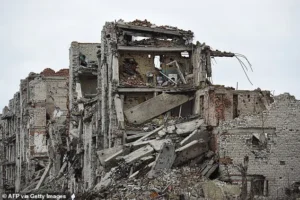
The ruined town of Maryinka, in Donetsk, Russian-controlled Ukraine, on April 1, 2025
Trending
PLATEAU KILLINGS: IGP ORDERS IMMEDIATE DEPLOYMENT OF ASSETS, TACTICAL SQUADS.
Published
7 hours agoon
April 9, 2025By
Ekwutos Blog
PRESS RELEASE
PLATEAU KILLINGS: IGP ORDERS IMMEDIATE DEPLOYMENT OF ASSETS, TACTICAL SQUADS.
As IGP Directs DIG Operations To Proceed To Plateau State.
In response to the deeply troubling series of attacks and killings that have plagued some communities of Plateau State since March 28, 2025, the Inspector-General of Police, IGP Kayode Adeolu Egbetokun, PhD., NPM., has ordered the immediate and comprehensive deployment of police tactical assets to the affected areas of the state. This decisive action underscores the Nigeria Police Force’s resolve to restoring peace, ensuring the safety and security of all residents, and bringing perpetrators of these heinous crimes to justice.
The IGP has specifically tasked the Deputy Inspector-General of Police in charge of the Department of Operations (DIG DOPs), DIG Kwazhi Dali Yakubu , mni., to lead and coordinate this critical intervention with significant reinforcements, including additional units of highly trained tactical personnel, state-of-the-art drones for enhanced surveillance, Armored Personnel Carriers (APCs), units of Police Mobile Force, helicopters, and specialized platoons from the Special Intervention Squad (SIS). These resources will be strategically deployed to conduct special operations aimed at effectively curbing the incessant attacks in Bokkos Local Government Area (LGA) and surrounding communities, which have tragically resulted in the loss of innocent lives.
The recent escalation of violence began on March 28, 2025, when some armed assailants launched a brutal attack in Bokkos, resulting in the deaths of some individuals and serious injuries to many others. This initial incident tragically marked the beginning of a series of attacks that have since claimed the lives of scores of people, leaving communities devastated and gripped by fear. Recognizing the gravity of the situation, the IGP has directed DIG Kwazhi and the deployed security forces to undertake a multi-faceted approach, focusing not only on suppressing the ongoing violence but also on proactively preventing future attacks.
Upon arrival in Plateau State on Tuesday, 8th April 2025, DIG Kwazhi paid a courtesy visit on the Executive Governor of Plateau State, His Excellency, Barr. Caleb Mutfwang. During this meeting, DIG Kwazhi conveyed the IGP’s sincere condolences to the affected families and communities, as well as to the entire people of Plateau State. The meeting also served as an opportunity to assess the situation firsthand, delve into the root causes of the attacks, and collaboratively develop a sustainable, long-term solution to these senseless killings.
The Nigeria Police Force, under the leadership of the Inspector-General of Police, remains fully committed to working in close collaboration with the Plateau State Government, community leaders, security agencies, and all relevant stakeholders to restore lasting peace and stability to the region. The NPF urges residents to cooperate with the Police and other security agencies, providing any information that may assist in the ongoing investigation and efforts to maintain peace on the Plateau.
ACP OLUMUYIWA ADEJOBI, mnipr, mipra, fCAI,
FORCE PUBLIC RELATIONS OFFICER,
FORCE HEADQUARTERS,
ABUJA.
9TH APRIL 2025

Ukraine seeks to reassure Brussels by drawing red lines on US minerals deal

‘Hon Natasha Osawaru nee Idibia’ – Reactions as 2baba’s fiancée introduces herself

Kneel before Wike, beg him – Former gov’ship candidate, Eradiri tells Fubara
Trending

 Trending6 months ago
Trending6 months agoNYA demands release of ‘abducted’ Imo chairman, preaches good governance
- Business6 months ago
US court acquits Air Peace boss, slams Mayfield $4000 fine

 Politics6 months ago
Politics6 months agoMexico’s new president causes concern just weeks before the US elections
- Entertainment6 months ago
Bobrisky transferred from Immigration to FCID, spends night behind bars
- Entertainment6 months ago
Bobrisky falls ill in police custody, rushed to hospital
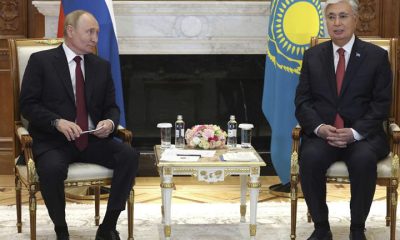
 Politics6 months ago
Politics6 months agoRussia bans imports of agro-products from Kazakhstan after refusal to join BRICS

 Politics6 months ago
Politics6 months agoPutin invites 20 world leaders
- Politics1 year ago
Nigerian Senate passes Bill seeking the establishment of the South East Development Commission.


